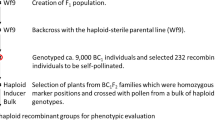Abstract
Rapeseed ranks third in world oil production. An important breeding objective to improve oil quality in this crop is to lower linolenic acid concentration in the seeds. Previous reports indicate that the concentration of this acid in Brassica napus is determined by two or three nuclear genes. Using DNA-based markers, we have successfully mapped a gene determining linolenic acid concentration in an F2 population derived from crossing the cultivar ‘Duplo’ and alow linolenic acid line, 3637-1. Linolenic acid concentration in this population ranged from 2.1% to 10.5% with-amean of 6.2%. A RAPD marker, K01-1100, displayed significantly different frequencies between two subpopulations consisting of either high or low linolenic acid concentration individuals sampled from the two extremes of the F2 distribution. Marker K01-1100 segregated in a codominant fashion when used as an RFLP probe on DNA from individuals of this F2 population. The linolenic acid concentration means for the three resulting RFLP genotypes in the F2 population were 4.8% (homozygous 3637-1 allele), 6.4% (heterozygous), and 7.5% (homozygous ‘Duplo’ allele), respectively. It is estimated that this marker accounts for 26.5% of the genetic variation of linolenic acid concentration in this population.
Similar content being viewed by others
References
Browse J, Somerville CR (1991) Glycerolipid synthesis: biochemistry and regulation. Annu Rev Plant Physiol Plant Mol Biol 42:467–506
Brunklaus-Jung E, Robbelen G (1987) Genetical and physiological investigations on mutants for polyenoic fatty acids in rapeseed (Brassica napus L.). III. Breeding behaviour and performance. Plant Breeding 98:9–16
Chen JL, Bevesdorf WD (1990) Fatty acid inheritance in microspore-derived populations of spring rapeseed (Brassica napus L.). Theor Appl Genet 80:465–469
Diepenbrock W, Wilson RF (1987) Genetic regulation of linolenic acid concentration in rapeseed. Crop Sci 27:75–77
Galliard T (1980) Degradation of acyl lipids: hydrolitic and oxidaive enzymes. In: Stumpf PK (ed) The biochemistry of plants, vol 4. Academic Press, New York, pp 85–116
Haley CS, Knott SA (1992) A simple regression method for mapping quantitative trait loci in line crosses using flanking markers. Heredity 69:315–324
Hu J, Quiros CF (1991) Identification of broccoli and cauliflower cultivars with RAPD markers. Plant Cell Rep 10:505–511
James DW Jr, Dooner HK (1990) Isolation of EMS-induced mutants in Arabidopsis altered in seed fatty acid composition. Theor Appl Genet 80:241–245
Kianian SF, Quiros CF (1992) Generation of a Brassica oleracea composite RFLP map: linkage arrangements among various populations and evolutionary implications. Theor Appl Genet 84:544–554
Lebowitz RJ, Soller M, Beckmann JS (1987) Trait-based analyses for the detection of linkage between marker loci and quantitative trait loci in crosses between inbred lines. Theor Appl Genet 73:556–562
Lemieux B, Miquel M, Somerville C, Browse J (1990) Mutants of Arabidopsis with alterations in seed lipid fatty acid composition. Theor Appl Genet 80:234–240
Michelmore RW, Para I, Kesselli R (1991) Identification of markers linked to disease-resistance genes by bulked segregant analysis: a rapid method to detect markers in specific genomic regions by using segregating populations. Proc Natl Acad Sci USA 88:9828–9832
Miquel M, Browse J (1992) Arabidopsis mutants deficient in poly-unsaturated fatty acid synthesis. J Biol Chem 267:1502–1509
Nagai J, Bloch K (1968) Enzymatic desaturation of stearyl ACP. J Biol Chem 243:4626–4633
Pleines S, Friedt W (1989) Genetic control of LA concentration in seed oil of rapeseed (Brassica napus L). Theor Appl Genet 78:793–797
Robbelen G, Nitsch A (1975) Genetical and physiological investigation on mutants for polyenoic fatty acids in rapeseed (Brassica napus L.). I. Selection and description of new mutants. Z Pflanzenzucht 75:93–105
Roughan PG (1985) Cytidine triphasphate-dependent acyl-CoA-independent synthesis of phosphatidylglycerol by chloroplasts isolated from spinach and pea. Biochim Biophys Acta 835:527–532
Roughan PG, Slack CR (1982) Celullar organization of glycerolipid metabolism. Annu Rev Plant Physiol 33:97–132
Roy NN, Tarr AW (1986) Development of near-zero linolenic acid (18): (3) lines of rapeseed (Brassica napus L.). Plant Breed 96:218–223
Thies W (1971) Schnelle und einfache Analysen der Fettsaure-Zusammensetzung in einzelnen Raps Kotylodonen. I. Gaschromatographische und papierchromatographische Methoden. Z Pflanzenzucht 65:181–202
Author information
Authors and Affiliations
Additional information
Communicated by H. K. Dooner
Rights and permissions
About this article
Cite this article
Hu, J., Quiros, C., Arus, P. et al. Mapping of a gene determining linolenic acid concentration in rapeseed with DNA-based markers. Theoret. Appl. Genetics 90, 258–262 (1995). https://doi.org/10.1007/BF00222211
Received:
Accepted:
Issue Date:
DOI: https://doi.org/10.1007/BF00222211




